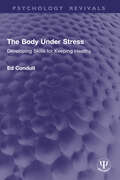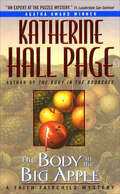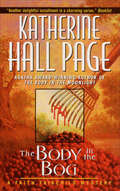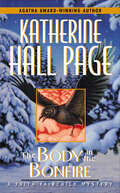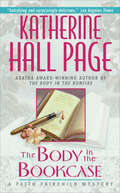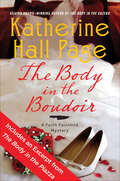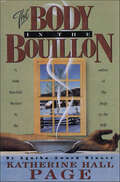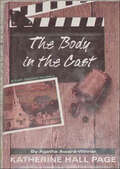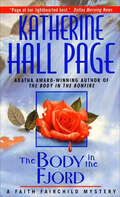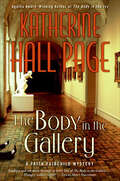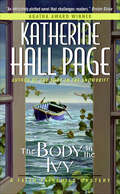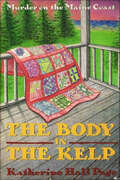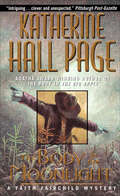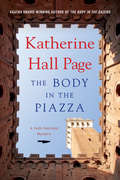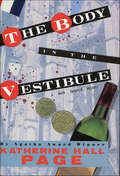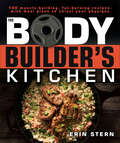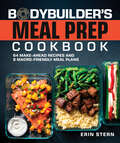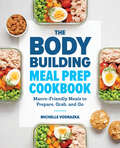- Table View
- List View
The Body Shape Solution to Weight Loss and Wellness: The Apples & Pears Approach to Losing Weight, Living Longer, and Feeling Healthier
by Marie Savard Carol SvecWhen it comes to your health, body shape really does matter! No matter what your current weight or how well you take care of yourself, whether you're a teenager or postmenopausal, this book will change the way you relate to your body forever. That's the power of body shape -- and it's as easy as knowing the difference between apples and pears! If you tend to gain weight in your belly and back, you're an apple. If your thighs and derriere are where you bear extra baggage, you're a pear. But do you know that your fruit IQ is the single most powerful predictor of future health? Body type directly affects your likelihood for obesity, heart disease, osteoporosis, diabetes, stroke, varicose veins, and certain cancers. But, as medical pioneer and ABC's women's health expert Marie Savard, M.D., explains in this ground-breaking book, there are things you can do to prevent or even reverse the risks of body shape. The Body Shape Solution to Weight Loss and Wellness can help you: understand what body shape means, and how it relates to your health learn how to distinguish between subcutaneous and visceral fat -- butt or gut! -- and discover why all fat is not created equal discover the Elite foods that help protect against disease and improve your odds of shedding fat acquire the tools you need to make conscious, informed, healthy choices about food throw away your scale and get out of the cycle of diet failure -- for good! Work with your body -- not against it -- to achieve maximum health and look your best!
The Body Under Stress: Developing Skills for Keeping Healthy (Psychology Revivals)
by Ed ConduitOriginally published in 1995, The Body Under Stress, reissued here with a new preface, seeks to define positive health, the skills needed to acquire it, and how to pass them on to others as part of education and counselling on health issues.Most people now view health as “fitness” – a repertoire of skills or health behaviours, necessary to overcome: excessive workload; bereavement; reliance on alcohol, tobacco or other drugs; over-use of back or neck. While many of these behaviours are acquired informally, some need to be taught by health professionals. This need was being recognized at a time when health services were increasing their interest in the maintenance of health, in addition to the treatment of illness.A scientific approach to positive health is relevant equally to medical and complementary health practices. The second half of this book examines the evidence that health behaviours can prevent illnesses such as: heart disease; ulcers; back injuries.A comprehensive review of the research and development at the time, this book will still be of interest to many health professionals for whom patient education and counselling is a major part of their role. This includes many nurses, remedial therapists, clinical and health psychologists, and complementary practitioners. Such readers, and clients wishing to make better use of consultations with their doctors, will find this book an indispensable storehouse of information.
The Body Wars: Why body dissatisfaction is at epidemic proportions and how we can fight back
by Dr Aric SigmanGirls and women of all ages have never been more unhappy with their bodies. And research shows that slim women are often no more satisfied with their bodies than overweight ones. Forty years after the debut of body politics, fat is more of a feminist issue than ever.So why has body dissatisfaction become the norm? Why are children as young as 3 years of age worried about their appearance? Why are eating disorders, weight and shape concerns affecting so many women? And what can we do to deal with the negative effects this is having on people's lives?Leading psychologist Dr Aric Sigman tackles body dissatisfaction in a direct, uncompromising way, examining the leading research, identifying the key issues and contributing personal experiences. And he calls on the untapped army of husbands, partners and fathers to come out fighting to help change the way girls and women feel. The Body Wars also offers clear, practical solutions for individuals, parents and society to help reduce and prevent what is fast becoming a world-wide epidemic.
The Body by Science Question and Answer Book
by John R. Little Doug McguffFollowing publication of Body By Science, the public's interest in Dr. Doug McGuff's and John Little's evidence-based approach to exercise has increased dramatically, with the result that hundreds of questions have been posed and answered at the authors' various seminars, within magazine articles and on their website (www. bodybyscience. net). Such question-and-answer sessions provide an opportunity for the authors to expand on key points and principles within their book, as well as address important topics that were not included in Body By Science (such as rehabilitation issues, various training protocols, and long term health and safety issues). The Body By Science Question-And-Answer Book Is A Companion Volume To Body By Science that sheds additional light on the authors' rational, science-based approach to strength training, bodybuilding, and total fitness. Within the pages of this new book you will learn:-Why (and how) strength training is the best way to rehabilitate most common injuries (from rotator cuff issues and knee replacements to lower back pain and arthritis). -Why bodybuilding is not what it seems. -Why athletics may not be the best route to health and fitness-The truth about VO2 Max testing and REAL cardiovascular health. -The realities of nutrition and the "insulin problem. "-How to optimize your workouts and ensure that your training facility is set up to maximize your progress. Plus answers to many more important questions on various aspects of health, fitness and strength.
The Body in the Big Apple: A Faith Fairchild Mystery (The Faith Fairchild Series #10)
by Katherine Hall PageThe Agatha Award-winning author serves up a “prequel to the successful series featuring caterer Faith Fairchild . . . An excellent beginning” (Library Journal).Before she met and married the Reverend Thomas Fairchild and moved to sleepy little Aleford, Massachusetts, Faith Sibley Fairchild had a catering business in the most colorful, frenetic, and exciting city in the world . . . Young, ambitious and single in New York City in the late ’80s, Faith Sibley is energized by the early success of her Have Faith catering enterprise. But she’s cast into an unexpected new role when she runs into old high school friend Emma Stanstead at a swanky uptown party: sleuth! An anonymous blackmailer is threatening to expose certain secrets of socialite Emma’s less than glamorous past—thereby destroying her reputation and her conservative husband’s fast-rising political career—and Faith fearlessly leaps into the fray. Though she lacks experience, Faith’s keen instinct, insight, and determination to unmask an extortionist quickly carry her deep into the high and low life of the bustling Big Apple. And when a murder raises the stakes, Faith realizes that it’s not just her old friend’s good name that’s in peril . . . it’s Emma’s life itself.“[Page’s] young sleuth is a charmer.” —The New York Times Book Review“Fun . . . a little mystery with a big-hearted love of NYC . . . [Readers] will enjoy Big Apple.” —Denver Rocky Mountain News“New Yorkers and suburbanites alike should enjoy this fast-paced mystery; and gastronomes will relish the aptly apple-flavored recipes that complete this work.” —Publishers Weekly“Intimate and engaging.” —Mystery News
The Body in the Bog: A Faith Fairchild Mystery (The Faith Fairchild Series #7)
by Katherine Hall PageAgatha Award–Winning Author: A caterer gets mixed up in murder in &“another delightful installment in a charming series . . . complete with appealing recipes&” (Booklist). Faith Fairchild is momentarily shocked to find her husband, the Reverend Thomas Fairchild, embracing Lora Deane—and relieved to discover the distraught nursery school teacher is merely seeking solace and advice. Lora has been receiving threatening phone calls. And she&’s not the only resident of tiny Aleford, Massachusetts, who is being terrorized. Ever since local environmentalists began protesting the proposed housing development that will destroy Beecher&’s Bog, the more vocal opponents have become targets of a vicious campaign of intimidation—which is more than enough reason for Faith to launch into some clandestine sleuthing. But when a body turns up in the charred ruins of a very suspicious house fire, Faith is suddenly investigating a murder—and in serious danger of getting bogged down in a very lethal mess indeed . . . &“An expert at the puzzle mystery.&” —Fort Lauderdale Sun-Sentinel
The Body in the Bonfire (The Faith Fairchild Series #12)
by Katherine Hall Page“This whodunit provides fully satisfying fare for a cold winter’s night around the fire”—from the Agatha Award-winning author of The Body in the Moonlight (Publishers Weekly).Caterer and small-town minister’s wife Faith Fairchild might never have accepted the job teaching a course on Cooking for Idiots at Mansfield Academy had it not been for Daryl Martin. An African-American student at the prestigious prep school, Daryl has lately become the target of a series of vicious and anonymous racial attacks—and Faith is determined to put an end to the injustice. But Mansfield, she finds, is a seething cauldron of secrets, academic in-fighting, and unspoken rules that complicate her task. When someone tampers with her classroom cooking ingredients—and then the remains of her prime suspect are discovered smoldering in a campus bonfire—she realizes that a monstrous evil is stalking both Daryl and the school. And suddenly Faith’s own life is in serious jeopardy as well!“Skillful sleuthing . . . bon appetit.” —The Tampa Tribune“Faith’s fans are sure to be pleased with another of the author’s always readable stories.” —Kirkus Reviews“A deservedly popular series.” —Library Journal
The Body in the Bookcase: A Faith Fairchild Mystery (The Faith Fairchild Series #9)
by Katherine Hall PageA crime-solving caterer delves into the dark side of the New England antiques trade in the Agatha Award-winning, “highly entertaining series” (Booklist).Stretched almost to the limit by the capricious demands of a Boston Brahmin bride-to-be, caterer and minister’s wife Faith Fairchild faces real tragedy when she discovers the body of an elderly friend. Sarah Winslow had apparently surprised burglars ransacking her Aleford, Massachusetts, house. No sooner has Sarah been laid to rest than the Fairchilds find themselves the next target—the parsonage is stripped of all their most precious possessions. Devastated and furious, Faith takes action, scouring pawnshops, antique marts, and auctions. As she turns up some of their stolen property, she is drawn onto a dangerous path of larceny and corruption in New England’s venerable antique business—a path that soon leads Faith straight to a killer . . . “Peopled with entertaining and resourceful characters and sprinkled with mouth-watering recipes.” —Dallas Morning News“Satisfying and surprisingly delicious.” —Los Angeles Times
The Body in the Boudoir: A Faith Fairchild Mystery (The Faith Fairchild Series #20)
by Katherine Hall Page“Fans of the Faith Fairchild series will probably be over the moon for this prequel that lovingly details how Faith met her husband” (The Charlotte Observer).Massachusetts minister’s wife, caterer, and sometime amateur sleuth Faith Fairchild returns in The Body in the Boudoir, the twentieth installment in the Agatha Award-winning mystery series by Katherine Hall Page that provides mystery, heart, wit, suspense, and mouthwatering recipes aplenty.Page turns back the clock this time to 1990, as a young Faith Sibley prepares to wed the love of her life, Thomas Fairchild . . . if she can survive a malefactor who’s trying to disrupt the ceremony by doing away with the bride. Fans of cozy culinary mysteries, like the bestselling Goldy Schultz novels of Diane Mott Davidson, will adore the tasty mayhem Katherine Hall Page cooks up in her Boudoir.“Readers who might have drifted away from Katherine Hall Page’s pleasing mysteries starring Faith Fairchild, the congenitally curious wife of a New England minister and the proprietor of a catering company wittily named ‘Have Faith,’ should accept the homecoming invitation extended in The Body in the Boudoir.” —The New York Times Book Review“A rollicking adventure of intrigue and suspense, plus . . . it’s a lot of fun catching up with the past fun and shenanigans that Faith always manages to find herself embroiled in, and this is a very fitting way to celebrate such a huge milestone for this mystery series.” —Times Record News (Wichita Falls, Texas)“Cozy fans will be enthralled.” —Publishers Weekly“[A] fun yet intelligent and layered look at the story behind a favorite series.” —Booklist
The Body in the Bouillon: A Faith Fairchild Mystery (The Faith Fairchild Series #3)
by Katherine Hall PageA minister’s wife is determined to find out who’s preying on the residents of a New England retirement home in this acclaimed cozy mystery series.Minister’s wife, sometime sleuth, and culinary artist Faith Sibley Fairchild is intrigued by rumors of mysterious doings at Hubbard House—an elegant, secluded retirement home for the well-heeled Yankees of Aleford, Massachusetts. Determined to do some surreptitious snooping, she joins the pricey retreat’s flu-depleted kitchen staff, only to witness an aging resident collapse face-first into a bowl of Faith’s hot and savory bouillon.Faith barely has time to ponder the suspicious death before a blackmailing drug dealer turns up dead in her bedroom! Now one thing is clear to the amateur investigator: murder doesn’t just happen at Hubbard—it’s the house specialty. And Faith’s own demise might very well be the next item on the menu.
The Body in the Cast: A Faith Fairchild Mystery (The Faith Fairchild Series #5)
by Katherine Hall PageAn award-winning cozy author “provides an abundance of . . . vividly detailed food, a veritable host of characters, and just a bit of froth” (Library Journal).Hollywood has come to town—and Faith Fairchild has to feed it! Hired to cater meals for the movie crew that is filming a modern-day version of The Scarlet Letter in the tiny New England village of Aleford, Faith is eager to treat the talented tantrum-throwers to the best of her culinary delights.But an accusation that her famous Black Bean Soup is poison has left a bad taste in Faith’s mouth. Her exploration into the source of the nasty slander leads the amateur investigator behind the scenes to a shocking off-camera murder. And suddenly more than Faith’s reputation is at stake—her life itself could end up on the cutting room floor“Sprightly, with a light dusting of satire.” —Kirkus Reviews“A New England ambience that’s irresistable.” —The Hartford Courant“If you enjoy a lively read, you’re sure to like The Body in the Cast. The story really sparkles.” —Romantic Times Magazine“Spirited characterization and energetic plotting.” —Publishers Weekly“Readers will find treasures aplenty in these fast-flying pages.” —The Clarion-Ledger, Jackson, MS
The Body in the Castle Well: Bruno investigates as France's dark past reaches out to claim a new victim (The Dordogne Mysteries #12)
by Martin Walker'WILL MAKE READERS LONG FOR LAZY DAYS IN RURAL FRANCE' Irish IndependentMillions of readers worldwide are discovering the special world of Bruno, Chief of Police, and the Dordogne Mysteries. There's murder in paradise in the twelfth case for France's favourite cop in this addition to a beloved seriesA missing art student. An international investigation. A secret that will shatter Bruno's charming village of St Denis. A rich American art student is found dead at the bottom of a well in an ancient hilltop castle. The young woman, Claudia, had been working in the archives of an eminent French art historian, a crippled Resistance war hero, at his art-filled chateau. As Claudia's White House connections get the US Embassy and the FBI involved, Bruno traces the people and events that led to her fatal accident - or was it murder?Bruno learns that Claudia had been trying to buy the chateau and art collection of her tutor, even while her researches led her to suspect that some of his attributions may have been forged. This takes Bruno down a trail that leads him from the ruins of Berlin in 1945, to France's colonial war in Algeria.The long arm of French history has reached out to find a new victim, but can Bruno identify the killer - and prove his case?
The Body in the Castle Well: The Dordogne Mysteries 12 (The Dordogne Mysteries #12)
by Martin Walker'WILL MAKE READERS LONG FOR LAZY DAYS IN RURAL FRANCE' Irish Independent Millions of readers worldwide are discovering the special world of Bruno, Chief of Police, and the Dordogne Mysteries. There's murder in paradise in the twelfth case for France's favourite cop in this addition to a beloved series A missing art student. An international investigation. A secret that will shatter Bruno's charming village of St Denis. A rich American art student is found dead at the bottom of a well in an ancient hilltop castle. The young woman, Claudia, had been working in the archives of an eminent French art historian, a crippled Resistance war hero, at his art-filled chateau. As Claudia's White House connections get the US Embassy and the FBI involved, Bruno traces the people and events that led to her fatal accident - or was it murder? Bruno learns that Claudia had been trying to buy the chateau and art collection of her tutor, even while her researches led her to suspect that some of his attributions may have been forged. This takes Bruno down a trail that leads him from the ruins of Berlin in 1945, to France's colonial war in Algeria. The long arm of French history has reached out to find a new victim, but can Bruno identify the killer - and prove his case?(P)2019 Quercus Editions Limited
The Body in the Fjord: A Faith Fairchild Mystery (The Faith Fairchild Series #8)
by Katherine Hall Page“Eighth in a charming series, complete with food talk, stolen antiques, murder—and recipes” from the Agatha Award-winning author of The Body in the Bog (Library Journal).This time out, small-town caterer and minister’s wife Faith Fairchild’s neighbor, Pix Miller, takes center stage, heading off to Norway to investigate the sudden disappearance of a family friend. Determined to discover the truth, Pix is drawn into a suspenseful world of intrigue, stolen antiques, secret histories, and deadly echoes from Norway’s past and the Nazi occupation. Surrounded by the country’s breathtaking beauty, the ever-resourceful New Englander perseveres—until at last she finds herself face-to-face with a remorseless killer . . . with no way out.“An expert at the puzzle mystery . . . Page smoothly keeps her plot on course . . . The Body in the Fjord is a solid example of her skill.” —Fort Lauderdale Sun-Sentinel“Light and lively . . . a puzzling case of death and disappearance . . . leavened with humor and warmth.” —Boston Herald“Page at her lighthearted best.” —The Dallas Morning News
The Body in the Gallery: A Faith Fairchild Mystery (The Faith Fairchild Series #17)
by Katherine Hall PageA &“savory&” mystery featuring a crime-solving caterer and a murder at an art museum, from the Agatha Award–winning author (Publishers Weekly). Faith&’s catering business has been slow with the downturn of the economy, so when her friend Patsy Avery proposes that she take over the café at Aleford&’s Ganley Art Museum, it seems like a not-to-be-missed opportunity. And Patsy has an ulterior motive—she discovers that the Romare Bearden piece she lent the museum has been switched with a fake and wants Faith to snoop around to find the culprit. Faith is soon enmeshed in the Ganley&’s murky past and present as she struggles to make connections among apparently disparate items: the fake Bearden, Pepperidge Farm Goldfish crackers, and a Jane Doe corpse that turns up as an unintended part of an art installation. At home, her son, now in the hell known as middle school, becomes involved in a cyberbullying escapade, and her husband wants her to morph into June Cleaver. Her investigation takes her into Boston&’s art scene and historic Beacon Hill, as well as into the lives behind the façade of the Ganley&’s very proper board of trustees. But she is at her wit's—and almost dead—end, as the killer strikes again, and again . . . &“Intellect and wit shine through in every line of The Body in the Gallery . . . Hungry readers, enjoy!&” —Diane Mott DavidsonIncludes recipes!
The Body in the Ivy: A Faith Fairchild Mystery (The Faith Fairchild Series #16)
by Katherine Hall Page“This romantic mystery, filled with country-house atmosphere and cookery, offers an homage to Agatha Christie’s And Then There Were None . . . addictive.” —BooklistFaith Fairchild is asked to cater a very small, very private college reunion on an isolated New England island—an event that could be her dream job. But when she discovers the true reason for the get-together, not even the spectacular ocean views can keep it from turning into a nightmare. Thirty years ago, bestselling suspense writer Barbara Bailey Bishop lost her twin sister in a tower fall deemed a suicide. But Barbara is convinced that Hélène did not die by her own hand, and she’s trapped Hélène's former classmates—her prime suspects—at her home with no phone lines, no cell reception, and no means of escape.One by one, the alumnae fall prey to a madwoman. A disturbed sister’s revenge . . . or a former coed’s coverup? Faith must quickly unlock the secrets of Hélène’s last night if she wants to leave the island alive.“An intricately plotted novel that challenges readers.” —The Boston Globe“Page keeps the reader guessing to the very end. Cozy mystery buffs will enjoy trying to find the Christie references.” —Library Journal (starred review)“Readers of the series will relish this addition; Christie fans will enjoy an engaging tribute.” —Publishers Weekly“It may be impossible to surpass And Then There Were None, the obvious model here, but Page builds tension and makes us care about the suspects’ troubled lives.” —Kirkus Reviews
The Body in the Kelp: A Mystery (The Faith Fairchild Series #2)
by Katherine Hall PageThe second mystery in the Agatha Award–winning series: “Great characters, a wonderful plot, and a puzzle laid out in the unfinished threads of a quilt.” —Ocala Star-BannerNew York caterer-turned-minister’s wife Faith Fairchild and her husband, Tom, have left the little village of Aleford, Massachusetts for a summer on Sanpere Island, off the coast of Maine. But Tom is called away to a three-week religious retreat in New Hampshire, leaving Faith to amuse herself and care for Benjamin, who’s currently in what parents call the “terrible twos” stage.The summer begins innocently enough, with Faith involved in a seemingly harmless mystery—a hunt for treasure, the clues to which are cryptically embedded in a patchwork quilt she bought at an estate auction. But the trail leads instead to the body of another summer resident along the beach, and Faith is forced into more serious—and dangerous—kind of detection . . .“[A] highly entertaining series.” —Booklist“[Page’s] young sleuth is a charmer.” —The New York Times Book Review“Page is known for leavening her work with humor and warmth.” —The Boston Herald
The Body in the Moonlight: A Faith Fairchild Mystery (The Faith Fairchild Series #11)
by Katherine Hall PageThe Agatha Award–winning author of The Body in the Big Apple dishes up “scrumptious suspense” as a toxic tragedy rattles a New England village (Boston Herald).Minister’s wife Faith Fairchild is excited about catering her church’s restoration campaign kickoff at historic Ballou House. But when a beautiful young woman dies moments after finishing dessert, Faith is suddenly in serious trouble. Not only is her business in jeopardy—but Aleford’s wagging tongues are suggesting that Faith herself laced the goodie with cyanide, having discovered her husband Tom’s perhaps overly pastoral interest in the victim. Faith’s world feels steeped in poison and never before have her amateur sleuthing skills been more crucial—especially when another body is found in the moonlight carrying an unmistakable warning: you’re next!“Intriguing . . . clever and unexpected.” —Pittsburgh Post-Gazette“Enchanting . . . well-written . . . Page’s style is entertaining and unpretentiously cultured.” —Portland Herald
The Body in the Piazza
by Katherine Hall PageFaith Fairchild is going to Italy, where murder and mayhem mix with pecorino, panna cotta, and Prosecco, in the latest entry in this "highly entertaining mystery series that] effectively mixes modern-day moral dilemmas with charm, warmth, and humor" (Booklist)The Body in the PiazzaTo celebrate their wedding anniversary, intrepid caterer and sometime sleuth Faith Fairchild and her husband, the Reverend Tom Fairchild, are off to Italy for a vacation filled with exquisite indulgences--the art, the Chianti, the food, the Ferragamos The plan is to spend a romantic weekend in Rome before heading to Tuscany for a stay at Cucina della Rossi, a cooking school founded by Faiths back-in-the-day assistant Francesca Rossi. Faith is certain that the only intrigue in store for her will be learning the secret recipe for Nona Rossis ragu. But a thicker plot begins to simmer when the Fairchilds accidentally stumble upon a dying man in the Piazza Farnese. Its clear from the knife in the victims chest that murder is on the menu. Mysterious faces from Rome reappear in Tuscany. To Faith, this is no coincidence. And somebody is intent on sabotaging Francescas new business by spoiling the cream and salting the flour. As Faith struggles to follow a trail more twisting than fusilli, she may be putting both herself and her husband in hot water.
The Body in the Vestibule: A Faith Fairchild Mystery (The Faith Fairchild Series #4)
by Katherine Hall Page“Former Manhattan caterer Faith Fairchild and her family find mystery in Lyons, France in this engrossing adventure” in the beloved cozy series (Publishers Weekly).Satisfying her hunger for epicurean adventure in the French provinces, small town caterer and minister’s wife Faith Fairchild decides to throw the perfect dinner party. But during cleanup after the last guest has departed her gastronomical triumph, she encounters something neither expected nor welcome: a dead body lying in her vestibule.Unfortunately it doesn’t help la belle americaine’s credibility when the corpse vanishes before the local gendarmes arrive. But Faith realizes that, though the police refuse to take her seriously, a killer just might. And if she doesn’t get to the bottom of this fiendish French conundrum, Faith’s successful feast could end up being her last.
The Body in the Wake: A Faith Fairchild Mystery (Faith Fairchild Mysteries #25)
by Katherine Hall PageAmateur detective and caterer Faith Fairchild is at her Penobscot Bay, Maine cottage preparing for a summer wedding, when she stumbles across . . . another body in this 25th entry in the beloved mystery series.For the first time in years, Faith Fairchild has time for herself. Her husband Tom is spending days on the other side of the island using a friend’s enhanced WiFi for a project; their son, Ben, after his first year in college, is studying abroad for the summer; and their daughter Amy is working at the old Laughing Gulls Lodge, now a revamped conference center.Faith is looking forward to some projects of her own. Her friend Sophie Maxwell is also spending the summer on Sanpere Island, hoping for distractions from her worries that she isn’t yet pregnant. And the daughter of Faith’s good friend Pix Miller is getting married to a wonderful guy . . . with a less-than-wonderful mother. Between keeping Sophie’s spirits up and Pix’s blood pressure down, Faith has her hands full.And that’s before a body with a mysterious tattoo and connections far away from small Sanpere Island appears in the Lily Pond. Once again, Faith will get to the bottom of this strange case—and whip up a delicious blueberry buckle on the side.
The Bodybuilder's Kitchen: 100 Muscle-Building, Fat Burning Recipes, with Meal Plans to Chisel Your Physiqu (The\bodybuilder's Kitchen Ser.)
by Erin SternBuild muscle, burn fat, and chisel your physique with 100 delicious recipes and customized bodybuilding meal plans.Ever wonder how professional bodybuilders get that herculean look? Well, you might be surprised to know it&’s as much about what happens in the kitchen as it is about what happens in the gym. Professional bodybuilders fuel their bodies with specific nutrients delivered at precise intervals to achieve their sculpted physiques, and now you can too! The Bodybuilder's Kitchen provides expert guidance on what to eat and when to eat it, and helps you understand how your body uses what you eat to burn fat and build lean, strong muscle. What are you waiting for? Dive right in to discover:- 100 delicious recipes for every mealtime with key macronutrients and nutrition panels provided for every recipe- 5 custom-designed meal plans for bulking and cutting phases, as well as plans for ketogenic dieting, calorie cycling, and carb cycling - Strategic guidance on when to eat, what to eat, and how to manage your nutrition for optimum fat-burning and muscle-building results With five weekly meal plans, 100 mouth-watering recipes, and expert insight from champion bodybuilder Erin Stern, this much-needed nutrition book will provide you with everything you need to fuel your workouts and achieve the bodybuilder physique. From salads to sides, meal prep planning to protein bars, this body-building book will be your one-stop guide to bulking up!Feel like having a more chiseled physique this New Year? Whether it&’s a New Year&’s Resolution to be more musclebound, or you&’re simply seeking expert guidance on fueling your body to meet your fitness needs, this all-encompassing strength-training guide may be exactly what you&’re looking for!Join the journey to becoming your strongest self today!
The Bodybuilder's Meal Prep Cookbook: 64 Make-Ahead Recipes and 8 Macro-Friendly Meal Plans
by Erin SternWith 64 delicious recipes and 8 weekly meal prep plans, this is the cookbook every bodybuilder needs!Every bodybuilder knows it can be difficult to plan weekly meals, cook every night, and also stick to your macros. Meal prep can make the task a whole lot easier, but it can also seem overwhelming if you don't know where to start. Now, two-time Ms. Figure Olympia and fitness trainer and coach Erin Stern makes it's simple, with 64 absolutely delicious recipe and 8 weekly prep plans, you'll never get bored with eating the same meals every week, and you'll also get to enjoy amazing recipes that actually taste good and help you reach your training goals. Each weekly prep plan includes eight recipes along with detailed prep plans that help you prepare meals for the upcoming week that will keep you satisfied and on track.Here's what's inside:8 weekly step-by-step prep plans with detailed shopping lists. Each plan targets a unique training goal, whether you're looking to build muscle, lean down, or just maintain. 64 delicious recipes for breakfasts, sides, salads, entrees, snacks, and even desserts. Helpful tips for sticking to your plans, shopping smart, and modifying the plans to meet your personal goals.
The Bodybuilding Meal Prep Cookbook: Macro-Friendly Meals to Prepare, Grab, and Go
by Michelle VodrazkaFuel bodybuilding success with macronutrient meal prepSculpting your ideal body demands hard work, dedication, and the right diet. The Bodybuilding Meal Prep Cookbook will help you achieve a lean, chiseled look with an array of macro-rich dishes that can be prepped quickly and enjoyed on the go.What sets this bodybuilding cookbook apart:6-week meal plan—This step-by-step guide does the heavy lifting for you, laying out what you should make each week to achieve your fitness goals, providing shopping and equipment lists, and guiding you through any advanced prep work.Success beyond 6 weeks—This cookbook includes 40+ additional recipes that allow you to seamlessly create and customize your meals far past the initial 6-week plan.Optimize your intake—Each recipe contains comprehensive nutritional calculations, so you know the exact calorie count and the amount of protein, carbs, and fat you're getting.Pump up your meal prep for the physique you seek with this indispensable bodybuilding cookbook.
The Boletes of China: Tylopilus s.l.
by Yan-Chun Li Zhu L. YangThis book introduces the Chinese boletes, including the history, ecological and economic values, as well as the geographical distribution patterns with a highlight on the Tylopilus species. Species in Tylopilus s.l. are not only of important ecological values but also of scientific interests. They are very diverse in morphology, complex in structure and wide in ecological niches. China is one of the diverse hotspots of boletes, and many boletes were traditionally treated as members of Tylopilus based on hymenophore or spore-print colour. The studies revealed that the traditionally defined Tylopilus is polyphyletic. This book aims to elucidate the phylogenetic relationships among the genera treated in Tylopilus s.l. previously; to delimit and recognize the taxa, and finally to reveal the diversity of the genera and species of Tylopilus s.l. in China. The book is intended to be a reference for biologists who conduct investigations of biological resources and biodiversity; university and college teachers and students carrying out studies in related fields; mycologists and amateur mycologists, or people who interested in mushrooms taxonomy and systematics; and workers in the development of non-timber forest products.

